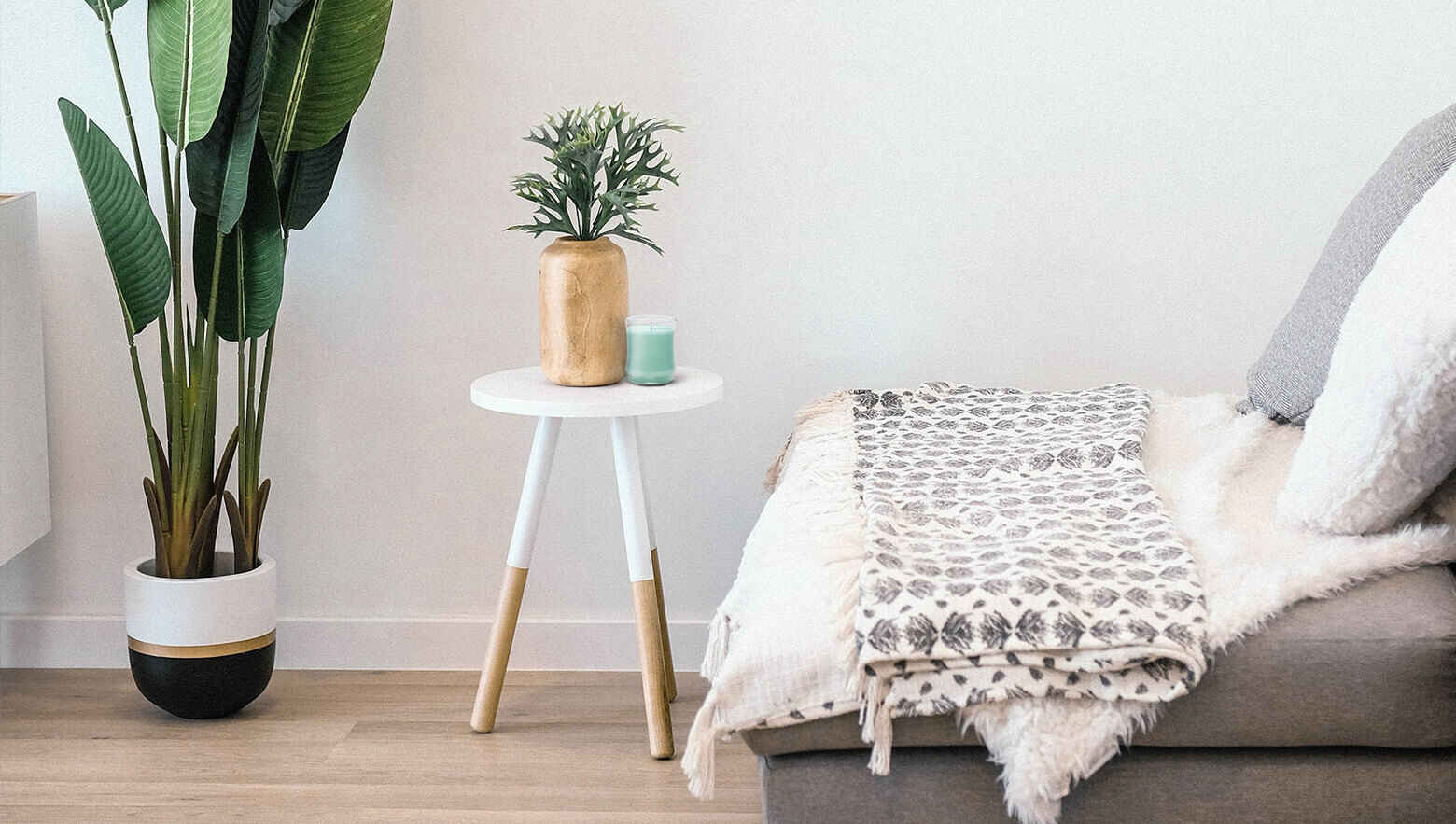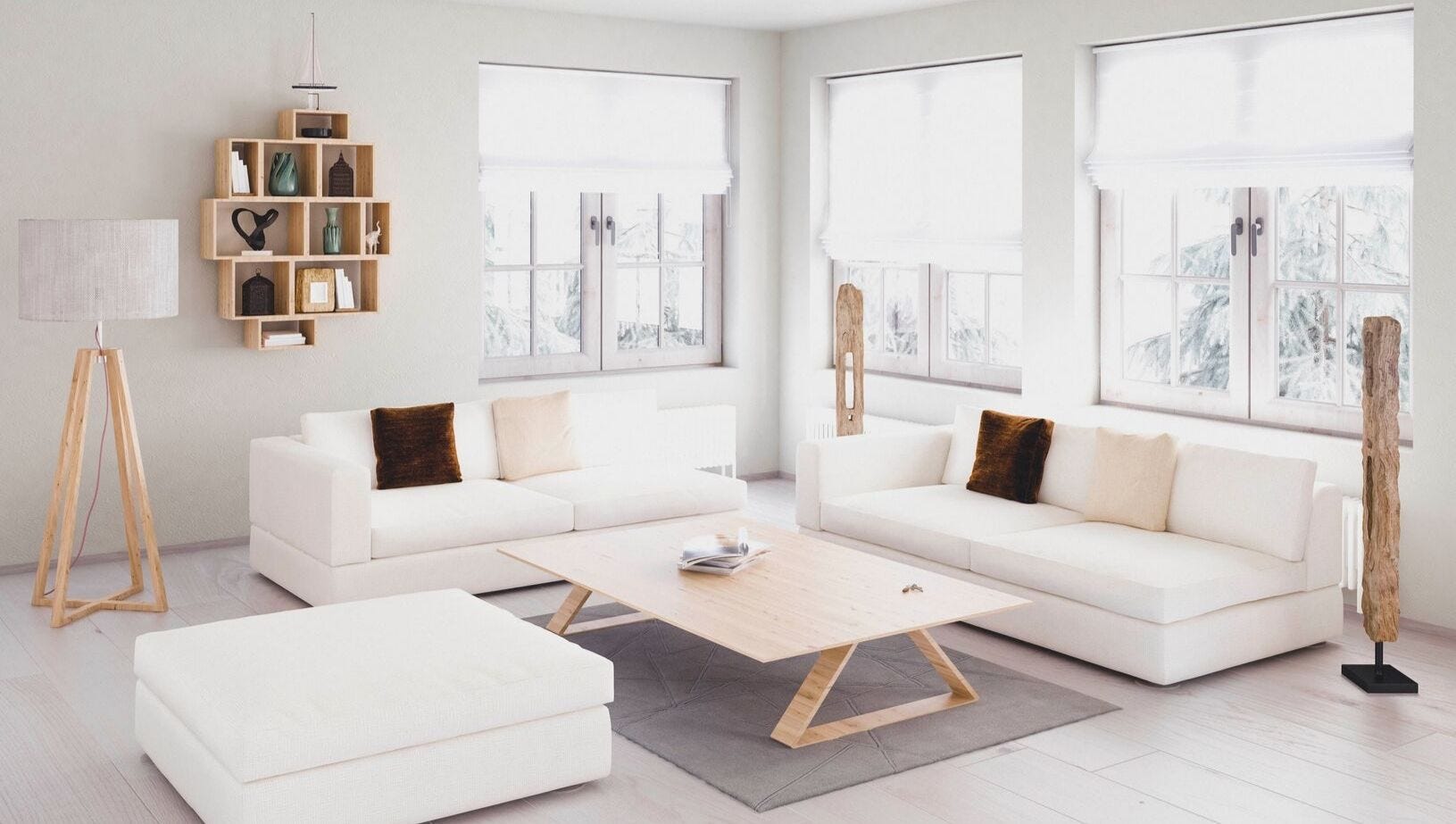Being able to decorate a new home that is finally yours, and only yours, is a special moment in life. From being able to pick your own sofa to drilling holes in the walls, it can be hard to reign in your excitement, however, impulsive decoration can lead to disappointment and frustration. Whether you’ve been too eager to shop for furniture, or have overlooked the planning stage, it’s easy to fall into some of the basic interior design traps. That’s why we’ve listed our top 18 home décor mistakes and how you can avoid them. We’ve made these mistakes so you don’t have to. Read on to discover the decorating tips to transform a new home into your dream living space.
#1. Shopping for everything at once and only at one store
Don’t give into convenience and be tempted to pick up all of your furniture on one shopping trip. Before you even think to buy one piece of furniture, even if it’s a small item, you should plan out your theme, décor vision and colour palette. Once you’ve got a style in mind, then you can begin shopping.
Buying everything at once could mean that you end up with items that don’t actually work well with your new home, or fit in with other pieces that you’ve bought. Save yourself time and money by living in your home first, and patiently collecting pieces as you go. This way, you’ll get a really good sense of what you actually need. Take your time to scout about different stores and carefully find the pieces that you really like, rather than settling for just what’s available in one shop. Variety is the spice of life after all.

#2. Not measuring your space before you start shopping
This sounds obvious, but we’ve all been there. You’ve seen something you like, couldn’t wait to buy it and ran home to realise that it doesn’t actually fit. A tragic tale that can be easily avoided if you find out the exact measurements that you have to work with beforehand. Eyeballing it just isn’t going to cut it in this scenario we’re afraid. So don’t forget to take your tape measure with you when you shop for your furniture. It’s always safe to give yourself a few centimeters of leeway for larger items too, unless you’re looking for that exact fit.
Online shopping for furniture is useful if you’re looking for items in a specific size as most online retailers provide exact dimensions of their products.
#3. Painting too many accent walls
The idea behind an accent wall is to create a focal point in a room to draw attention to. While they can be really effective, if you paint an accent wall in every room, they may begin to lose their effect.
Accent walls work really well to highlight unique structural features, such as a fireplace or archway. Consider only implementing one if you have something it will work well with, rather than for the sake of having one. If you already have a strong colour scheme in place through your furniture, foregoing an accent wall for a neutral background can make your décor stand out further and be a good base to build on instead.

#4. Not taking scale into account
So you’ve taken all of the precautions to ensure your furniture fits into your new home, but it still doesn’t look right? That’s probably because you’ve not considered the size of your furniture in relation to the size of your house. Scale is important in keeping your décor well balanced.
For example, if you have less space, opt for smaller furniture or furniture that’s less bulky. Don’t choose a sofa that’s going to take up most of the room in your living room. For those of you with high ceilings, consider pieces that have height to them to avoid a bottom-heavy feel.
Scale is all about having a mixture of sizes and heights to create a well-varied room. A well scaled space shouldn’t look cluttered or empty, and the contents should all work in harmony.
#5. Painting small rooms in dark colours
If you have a small room, the last thing you want to do is close it up and make it look even more cramped. Selecting a darker shade for the walls can help to bring an element of cosiness, but it can also make your room feel smaller. For those of you with tiny bedrooms or small living rooms, opt for lighter tones to reflect light and create the illusion of a bigger space. Fake the space that you don’t have by choosing creams, off-whites and light pastel colours.

#6. Matching all of your furniture together
After you’ve found a theme that you want to follow, it can be easy to fall into the mindset of only finding décor and furniture that fits within that theme. This overly matching look will only result in making your space look dated and limiting your creative freedom. Shopping to fit a specific décor style and match all of your pieces together, whether you like them or not, isn’t being true to your own style.
Buy the things you really love, rather than the items that you think should go together. While it’s fine to match your armchairs or pillows, we suggest avoiding matching your sofa to your armchairs and dressing table to your bed.
#7. Not playing to your new home’s strengths
Many new homeowners set off on their interior design journey with a preexisting vision in mind, without taking into consideration their new home itself. It’s always a good idea to assess the architectural style, structure and quirks of your house before you begin decorating. These features can really work to your advantage and give your home an interesting focal point.
For example, if you have a room which reflects the light in a peculiar way, experiment with different paint shades to find that unique finish. Quirky structural elements like archways, windows, fireplaces and staircases should be celebrated and highlighted as they’re things that don’t come around often!
#8. Pushing all your furniture up against the wall
Fight the urge to push all of your larger furniture items up against the wall, as you’ll be left with an awkward amount of space in the middle of your room that will be difficult to fill. Framing your space like this can make your room look out of balance and rigid.
Instead, try floating your furniture by mixing up the placement of things. Have some items against the wall but also pull some out to float away from the sides. This more varied arrangement can drastically change the feel of your space, and give off a welcoming and intimate vibe.

#9. Not doing paint patch tests before painting the whole wall
Save yourself time, money and effort by being 100% sure on the paint colour you want before committing to it. Pick up a few paint shade cards to get an idea of what type of colour you want, and then purchase a tester pot to carry out a small swatch out on part of the wall you want to paint. Give the patch a few days to sit before deciding.
Natural and artificial lighting can really change how the colour appears. Your fully furnished room can even have an impact on your colour choice, so don’t forget to take these factors into consideration.
#10. Feeling pressured to keep and display all your family heirlooms
Whether it’s your grandmother’s bureau or the vase you got as a wedding gift, we all have those not-so-pretty pieces of furniture we feel obliged to hang on to. Don’t let that guilt overcome you and force you into filling your home with items that you don’t really like.
If it doesn’t bring you joy, you have our full permission not to feel bad about putting it away in a cupboard. Or if you’re low on storage space, consider asking permission to sell or give it away.

#11. Forgetting the function of a room
As important as it is to make your home look beautiful, don’t forget that above all else it needs to be functional. Interior design magazines and showrooms can be great places to gather ideas, but they might not look or feel the same when replicated in your home.
Always consider practicality and how things will work in the space that you have. Think about how many pieces of furniture you actually need, how the room will function at different times of the year and what the purpose of the room is.
#12. Overdoing a theme
Similar to matching all of your furniture together, if you match your whole interior style throughout your home, it’s easy to over do it. Themes are for guidance and don’t need to be followed super strictly. Crowding your space with too much of one theme, especially in smaller homes, can have the opposite effect and make it look tasteless and garish.
Throw in a few mixed pieces to bring variety and character. It will do wonders in making your space feel cosy and lived in.
#13. Foregoing a focal point or having too many
Focal points are perfect for catching the eye and giving your space a purpose. From a TV to a painting, or an interesting light fixture to a large mirror, it’s important that every room has a spot for people to focus on. They can hugely affect the overall impact and function of a room.
However, by creating too many focal points, you lose the effect and end up with too many contrasting pieces competing for attention. Your space looks cluttered and confusing, with too many features battling for purpose.

#14. Buying furniture that’s overpriced or cheap
Being on a strict budget can lead you to stray towards more inexpensive options. For furnishings that you’ll want to refresh often, like cushions, side tables, paint and lighting, that’s fine, but you should invest more money in high quality pieces that you know you’ll want to keep for the long term. Sofas, beds, dining tables, doors, flooring, etc. Skimping out on these things can often show up as cheap and cause problems further down the line.
Be smart with your spending and allocate a higher budget allowance for the essentials that you’ll want to last. Then you can use whatever’s leftover on décor pieces for layering over the top. It’ll be less obvious if these aren’t as good quality and there will be less heartbreak should they break.

#15. Relying on the “big light”
A common misconception when decorating a new space is that you only need one main source of light. For smaller rooms you can probably get away with one central light, but you should really look to have a few points of light to illuminate a room.
As well as a big light, layer in different types of lighting so you can use your space in a more multifunctional way. Lamps, LED lights and candles give your home a more ambient feel for when you want to create a more atmospheric mood.
GloLite by PartyLite® are the perfect candles to add ambiance into any room. No ordinary candle, our GloLites have been specially crafted with our patented glow technology so that they glow from top to bottom when lit. Available in a range of fragrances and forms, there’s a GloLite to suit everyone!
#16. Leaving the walls empty/cluttering the walls with too much artwork
Added all of the furniture to your room but the space doesn’t look finished? If you’ve neglected your walls, that may be the source of the problem. Bare walls can make the space look barren, so to remedy it, look for some affordable artwork, an interesting shelf or a nice hanging mirror to stop it looking like a blank canvas. Art can transform your room and make it look more homely. And there’s so many different pieces to choose from to suit your existing décor.
Having said that, filling your walls with framed prints or hanging items can be easily over done. Too many filler pieces can cause the room to look cramped and busy. If there’s a large item that you really love, let it shine on its own. Be selective about what you want.
#17. Filling your home with too much furniture
If there’s one cliché quote to follow when you’re decorating your home, it’s that less is more. Now, we don’t mean you should make your space look bare, but try not to fit too much furniture into your house if you don’t need it.
For example, you might want to fill a room with lots of small decorative pieces, but too many trinkets can make the space look cluttered and messy. They’ll get lost amongst each other, and there won’t be a place for the eye to land. Small scale items can be harder to style too. A well established room can benefit from a few select, larger décor items.
#18. Decorating for a space you wish you had, not the space you have
And finally, it’s hard not to get disillusioned by beautiful home interiors on Pinterest and social media, but you have to be true to your personal taste and the structure and style of your home. You’re the one that’ll be living in it! Be honest with yourself about whether you really need something or not. Find the pieces that you love and can fit within your home.
How many of these mistakes have you made? For more home décor and styling advice, visit our blog today.













